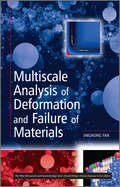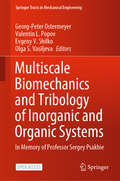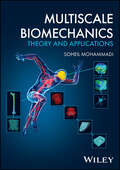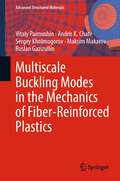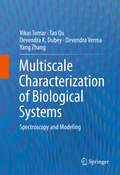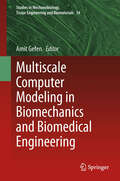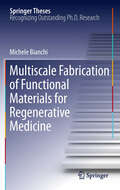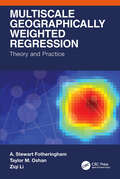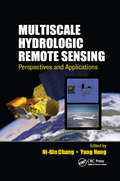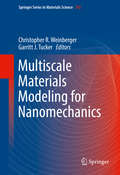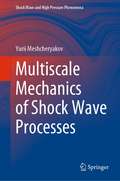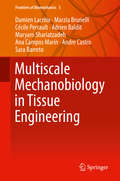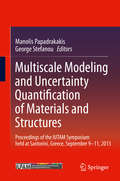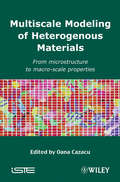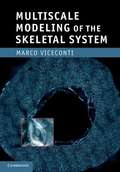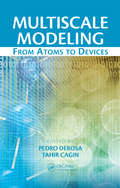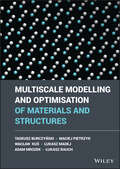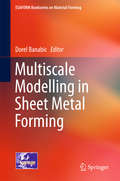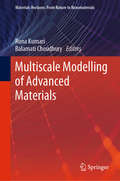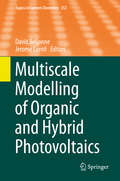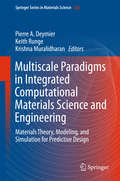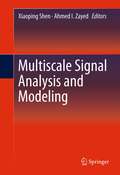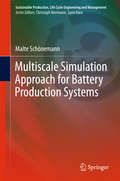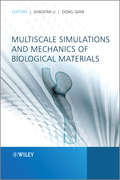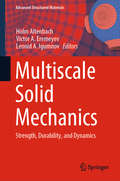- Table View
- List View
Multiscale Analysis of Deformation and Failure of Materials
by Jinghong FanPresenting cutting-edge research and development within multiscale modeling techniques and frameworks, Multiscale Analysis of Deformation and Failure of Materials systematically describes the background, principles and methods within this exciting new & interdisciplinary field.The author's approach emphasizes the principles and methods of atomistic simulation and its transition to the nano and sub-micron scale of a continuum, which is technically important for nanotechnology and biotechnology. He also pays close attention to multiscale analysis across the micro/meso/macroscopy of a continuum, which has a broad scope of applications encompassing different disciplines and practices, and is an essential extension of mesomechanics.Of equal interest to engineers, scientists, academics and students, Multiscale Analysis of Deformation and Failure of Materials is a multidisciplinary text relevant to those working in the areas of materials science, solid and computational mechanics, bioengineering and biomaterials, and aerospace, automotive, civil, and environmental engineering. Provides a deep understanding of multiscale analysis and its implementation Shows in detail how multiscale models can be developed from practical problems and how to use the multiscale methods and software to carry out simulations Discusses two interlinked categories of multiscale analysis; analysis spanning from the atomistic to the micro-continuum scales, and analysis across the micro/meso/macro scale of continuum.
Multiscale Biomechanics and Tribology of Inorganic and Organic Systems: In memory of Professor Sergey Psakhie (Springer Tracts in Mechanical Engineering)
by Valentin L. Popov Georg-Peter Ostermeyer Evgeny V. Shilko Olga S. VasiljevaThis open access book gathers authoritative contributions concerning multiscale problems in biomechanics, geomechanics, materials science and tribology. It is written in memory of Sergey Grigorievich Psakhie to feature various aspects of his multifaceted research interests, ranging from theoretical physics, computer modeling of materials and material characterization at the atomic scale, to applications in space industry, medicine and geotectonics, and including organizational, psychological and philosophical aspects of scientific research and teaching as well. This book covers new advances relating to orthopedic implants, concerning the physiological, tribological and materials aspects of their behavior; medical and geological applications of permeable fluid-saturated materials; earthquake dynamics together with aspects relating to their managed and gentle release; lubrication, wear and material transfer in natural and artificial joints; material research in manufacturing processes; hard-soft matter interaction, including adhesive and capillary effects; using nanostructures for influencing living cells and for cancer treatment; manufacturing of surfaces with desired properties; self-organization of hierarchical structures during plastic deformation and thermal treatment; mechanics of composites and coatings; and many more. Covering established knowledge as well as new models and methods, this book provides readers with a comprehensive overview of the field, yet also with extensive details on each single topic.
Multiscale Biomechanics: Theory and Applications
by Soheil MohammadiMULTISCALE BIOMECHANICS Model biomechanical problems at multiple scales with this cutting-edge technology Multiscale modelling is the set of techniques used to solve physical problems which exist at multiple scales either in space or time. It has been shown to have significant applications in biomechanics, the study of biological systems and their structures, which exist at scales from the macroscopic to the microscopic and beyond, and which produce a myriad of overlapping problems. The next generation of biomechanical researchers therefore has need of the latest multiscale modelling techniques. Multiscale Biomechanics offers a comprehensive introduction to these techniques and their biomechanical applications. It includes both the theory of multiscale biomechanical modelling and its practice, incorporating some of the latest research and surveying a wide range of multiscale methods. The result is a thorough yet accessible resource for researchers looking to gain an edge in their biomechanical modelling. Multiscale Biomechanics readers will find: Practical biomechanical applications for a variety of multiscale methods Detailed discussion of soft and hard tissues, and more An introduction to analysis of advanced topics ranging from stenting, drug delivery systems, and artificial intelligence in biomechanics Multiscale Biomechanics is a useful reference for researchers and scientists in any of the life sciences with an interest in biomechanics, as well as for graduate students in mechanical, biomechanical, biomedical, civil, material, and aerospace engineering.
Multiscale Buckling Modes in the Mechanics of Fiber-Reinforced Plastics (Advanced Structured Materials #207)
by Vitaly Paimushin Andris K. Chate Sergey Kholmogorov Maksim Makarov Ruslan GazizullinThis book is a useful source of knowledge for engineers and scientists in the field of mechanics of deformation and destruction of composite materials. In Chapter 1 three-dimensional equations of elasticity theory composed for the case of finite displacements and deformations of solids have been analyzed. It is found that the generally accepted simplifications known in the literature and carried out for the case of small deformations result in equations that are considered to be absolutely correct and consistent in all scientific and educational literature on mechanics of deformable solid bodies. However, this conclusion is not sufficiently well-founded as confirmed by formulation and solution of problems on the basis of generally accepted equations for determining both the stress-strain state (SSS) and the critical loads and buckling modes. In Chapter 2 the theoretical and experimental methods for determining the mechanical characteristics of fiber-reinforced plastics (FRPs) based on tensile and compression tests of flat specimens with [0]s , [±90]s, and [±45]2s lay-ups are analyzed. For FRPs with [±45]2s lay-ups, relations are derived for determining the components of lamina strains and stresses in the orthotropy axes of FRP monolayer in terms of axial strains and Poisson ratios of specimens measured in experiments. In Chapter 3 the structure of a unidirectional fibre composite of two types ELUR-P carbon fibre based on KhT-118 cold-curing binder and HSE 180 REM prepreg based on hot-curing binder has been studied. The diameters of fibres and fibre bundles (filaments) of both types of composites have been measured. Based on the results of the analysis of the composite material structure, a refined formulation of the linearised problems of a refined statement of linearized problems on flat internal multiscale buckling modes of a rigid lamina with either fibers or a fiber bundle is presented taking into account their interaction with an epoxy matrix. In Chapter 4 for shells of a layered structure based on the Timoshenko’s model, taking into account the transverse compression used for each layer, two versions of two-dimensional equations are constructed that describe geometrically nonlinear deformation with arbitrary displacements and small deformations. The formulation of a linear problem on the initial (subcritical) stress-strain state of a test specimen from a unidirectional fibrous composite with the [900]s structure during tension-compression tests with shear is given. A numerical method for solving the formulated problem is developed, which is based on the reduction of the original problem to a system of integro-algebraic equations and the search for their numerical solution by the finite sum method. In Chapter 5 conclusions were done and directions for further research have been identified.
Multiscale Characterization of Biological Systems
by Yang Zhang Vikas Tomar Tao Qu Devendra K. Dubey Devendra VermaThis book covers the latest research work done in the area of interface mechanics of collagen and chitin-based biomaterials along with various techniques that can be used to understand mechanics of biological systems and materials. Topics covered include Raman spectroscopy of biological systems, scale dependence of the mechanical properties and microstructure of crustaceans thin films as biomimetic materials, as well as the role of molecular-level modeling. The use of nanomechanics to investigate interface thermomechanics of collagen and chitin-based biomaterials is also covered in detail. This book also: * Details spectroscope experiments as well as nanomechanic experiments * Reviews exhaustively phenomenological models and Raman spectroscopy of biological systems * Covers the latest in multiscaling for molecular models to predict lab-scale sample properties and investigates interface thermomechanics
Multiscale Computer Modeling in Biomechanics and Biomedical Engineering
by Amit GefenThis book reviews the state-of-the-art in multiscale computer modeling, in terms of both accomplishments and challenges. The information in the book is particularly useful for biomedical engineers, medical physicists and researchers in systems biology, mathematical biology, micro-biomechanics and biomaterials who are interested in how to bridge between traditional biomedical engineering work at the organ and tissue scales, and the newer arenas of cellular and molecular bioengineering.
Multiscale Fabrication of Functional Materials for Regenerative Medicine
by Michele BianchiRegenerative medicine demands new concepts and fabrication tools to improve our common knowledge about cell-cell and cell-environment interactions. In this work, Michele Bianchi shows that different kinds of signals, such as chemical, topographical, and electrical signals, can be arranged in a highly-controlled way. Furthermore, Michele uses scale lengths ranging from several micrometers to a few nanometers, through the employment of unconventional fabrication techniques. For each signal, Michele chose properly designed materials and fabrication methods. The external signals are capable of controlling cell adhesion and growth, opening the way for a systematic investigation of the environmental features affecting cell behaviour.
Multiscale Geographically Weighted Regression: Theory and Practice
by A. Stewart Fotheringham Taylor M. Oshan Ziqi Li· Provides a balance between conceptual and technical introduction to local models · Explains state-of-the-art spatial analysis technique for multiscale regression modeling · Describes best practices and provides a detailed walkthrough of freely available software, through examples and comparisons with other common spatial data modeling techniques · Includes a detailed case study to demonstrate methods and software · Takes a new and exciting angle on local spatial modeling using MGWR, an innovation to the previous local modeling ‘bible’ GWR
Multiscale Hydrologic Remote Sensing: Perspectives and Applications
by Ni-Bin Chang Yang HongMultiscale Hydrologic Remote Sensing: Perspectives and Applications integrates advances in hydrologic science and innovative remote sensing technologies. Raising the visibility of interdisciplinary research on water resources, it offers a suite of tools and platforms for investigating spatially and temporally continuous hydrological variables and p
Multiscale Materials Modeling for Nanomechanics
by Christopher R. Weinberger Garritt J. TuckerThis book presents a unique combination of chapters that togetherprovide a practical introduction to multiscale modeling applied to nanoscalematerials mechanics. The goal of this book is to present a balancedtreatment of both the theory of the methodology, as well as some practicalaspects of conducting the simulations and models. The first half of thebook covers some fundamental modeling and simulation techniques ranging from ab-inito methods to the continuum scale. Included in this set of methods are several different concurrent multiscalemethods for bridging time and length scales applicable to mechanics at the nanoscaleregime. The second half of the book presents a range of casestudies from a varied selection of research groups focusing either on a the applicationof multiscale modeling to a specific nanomaterial, or novel analysis techniquesaimed at exploring nanomechanics. Readers are also directed tohelpful sites and other resources throughout the book where the simulationcodes and methodologies discussed herein can be accessed. Emphasis on thepracticality of the detailed techniques is especially felt in the latter halfof the book, which is dedicated to specific examples to studynanomechanics and multiscale materials behavior. An instructive avenue forlearning how to effectively apply these simulation tools to solve nanomechanicsproblems is to study previous endeavors. Therefore, each chapter iswritten by a unique team of experts who have used multiscale materials modelingto solve a practical nanomechanics problem. These chapters provide an extensivepicture of the multiscale materials landscape from problem statement throughthe final results and outlook, providing readers with a roadmap forincorporating these techniques into their own research.
Multiscale Mechanics of Shock Wave Processes (Shock Wave and High Pressure Phenomena)
by Yurii MeshcheryakovThis book presents theoretical and experimental investigations of mechanical behavior of solids under shock loading and highlights a multi-scale exchange process of energy and momentum between meso and macroscopic hierarchy. It also widely covers experimental approaches for the multi-scale response of solids to impacts including uniaxial strain conditions and high-velocity penetration processes. The content comprises two parts. The first part overviews modeling and theory of dynamically deformed solids from the multi-scale point of view. The second part describes experimental characterization of shock-induced solids and experimental probing of mesostructured and mesoscale dynamic processes in solids. The theory presented in the first part is then verified as it is compared with i) experiments of shock loading into different kinds of solids and ii) probed microstructure of post-shocked specimens by scanning electron microscopy, transmission electron microscopy and optical microscopy.The text is written on the basis of author’s lectures at universities and thus is concisely described for postgraduate students. It is also useful for researchers who work on the theory of multi-scale mechanics of solids and engineers who work on testing materials under dynamic loading.
Multiscale Mechanobiology in Tissue Engineering (Frontiers of Biomechanics #3)
by Damien Lacroix Marzia Brunelli Cécile Perrault Adrien Baldit Maryam Shariatzadeh Ana Campos Marin Andre Castro Sara BarretoThis book focuses on the mechanobiological principles in tissue engineering with a particular emphasis on the multiscale aspects of the translation of mechanical forces from bioreactors down to the cellular level. The book contributes to a better understanding of the design and use of bioreactors for tissue engineering and the use of mechanical loading to optimize in vitro cell culture conditions. It covers experimental and computational approaches and the combination of both to show the benefits that computational modelling can bring to experimentalists when studying in vitro cell culture within a scaffold. With topics from multidisciplinary fields of the life sciences, medicine, and engineering, this work provides a novel approach to the use of engineering tools for the optimization of biological processes and its application to regenerative medicine. The volume is a valuable resource for researchers and graduate students studying mechanobiology and tissue engineering. For undergraduate students it also provides deep insight into tissue engineering and its use in the design of bioreactors. The book is supplemented with extensive references for all chapters to help the reader to progress through the study of each topic.
Multiscale Modeling and Uncertainty Quantification of Materials and Structures
by Manolis Papadrakakis George StefanouThis book contains the proceedings of the IUTAM Symposium on Multiscale Modeling and Uncertainty Quantification of Materials and Structures that was held at Santorini, Greece, September 9 - 11, 2013. It consists of 20 chapters which are divided in five thematic topics: Damage and fracture, homogenization, inverse problems-identification, multiscale stochastic mechanics and stochastic dynamics. Over the last few years, the intense research activity at micro scale and nano scale reflected the need to account for disparate levels of uncertainty from various sources and across scales. As even over-refined deterministic approaches are not able to account for this issue, an efficient blending of stochastic and multiscale methodologies is required to provide a rational framework for the analysis and design of materials and structures. The purpose of this IUTAM Symposium was to promote achievements in uncertainty quantification combined with multiscale modeling and to encourage research and development in this growing field with the aim of improving the safety and reliability of engineered materials and structures. Special emphasis was placed on multiscale material modeling and simulation as well as on the multiscale analysis and uncertainty quantification of fracture mechanics of heterogeneous media. The homogenization of two-phase random media was also thoroughly examined in several presentations. Various topics of multiscale stochastic mechanics, such as identification of material models, scale coupling, modeling of random microstructures, analysis of CNT-reinforced composites and stochastic finite elements, have been analyzed and discussed. A large number of papers were finally devoted to innovative methods in stochastic dynamics.
Multiscale Modeling of Heterogenous Materials: From Microstructure to Macro-Scale Properties
by Oana CazacuA material's various proprieties is based on its microscopic and nanoscale structures. This book provides an overview of recent advances in computational methods for linking phenomena in systems that span large ranges of time and spatial scales. Particular attention is given to predicting macroscopic properties based on subscale behaviors. Given the book’s extensive coverage of multi-scale methods for modeling both metallic and geologic materials, it will be an invaluable reading for graduate students, scientists, and practitioners alike.
Multiscale Modeling of the Skeletal System
by Marco VicecontiIntegrative approaches to biomedical research promise to advance our understanding of the human body and physiopathology of diseases. In this book, the author focuses on the skeletal system, demonstrating how multiscale modeling can determine the relationship between bone mechanics and disease. Introductory chapters explain the concept of integrative research, what a model is, predictive modeling, and the computational methods used throughout the book. Starting with whole body anatomy, physiology and modeling, subsequent chapters scale down from bone and tissue levels to the cellular level, where the modeling of mechanobiological processes is addressed. Finally, the principles are applied to address truly complex, multiscale interactions. Special attention is given to real-world clinical applications: one in pediatric skeletal oncology and one on the prediction of fracture risks in osteoporotic patients. This book has wide interdisciplinary appeal and is a valuable resource for researchers in mechanical and biomedical engineering, quantitative physiology and computational biology.
Multiscale Modeling: From Atoms to Devices
by PEDRO DEROSA TAHIR CAGINWhile the relevant features and properties of nanosystems necessarily depend on nanoscopic details, their performance resides in the macroscopic world. To rationally develop and accurately predict performance of these systems we must tackle problems where multiple length and time scales are coupled. Rather than forcing a single modeling approach to
Multiscale Modelling and Optimisation of Materials and Structures
by Tadeusz Burczynski Maciej Pietrzyk Waclaw Kus Lukasz Madej Adam Mrozek Lukasz RauchAddresses the very topical, crucial and original subject of parameter identification and optimization within multiscale modeling methods Multiscale Modelling and Optimization of Materials and Structures presents an important and challenging area of research that enables the design of new materials and structures with better quality, strength and performance parameters as well as the creation of reliable models that take into account structural, material and topological properties at different scales. The authors’ approach is four-fold; 1) the basic principles of micro and nano scale modeling techniques; 2) the connection of micro and/or nano scale models with macro simulation software; 3) optimization development in the framework of multiscale engineering and the solution of identification problems; 4) the computer science techniques used in this model and advice for scientists interested in developing their own models and software for multiscale analysis and optimization. The authors present several approaches such as the bridging and homogenization methods, as well as the general formulation of complex optimization and identification problems in multiscale modelling. They apply global optimization algorithms based on robust bioinspired algorithms, proposing parallel and multi-subpopulation approaches in order to speed-up computations, and discuss several numerical examples of multiscale modeling, optimization and identification of composite and functionally graded engineering materials and bone tissues. Multiscale Modelling and Optimization of Materials and Structures is thereby a valuable source of information for young scientists and students looking to develop their own models, write their own computer programs and implement them into simulation systems. Describes micro and nano scale models developed by the authors along with case studies of analysis and optimization Discusses the problems of computing costs, efficiency of information transfer, effective use of the computer memory and several other aspects of development of multiscale models Includes real physical, chemical and experimental studies with modern experimental techniques Provides a valuable source of information for young scientists and students looking to develop their own models, write their own computer programs, and implement them into simulation systems.
Multiscale Modelling in Sheet Metal Forming
by Dorel BanabicThis book gives a unified presentation of the research performed in the field of multiscale modelling in sheet metal forming over the course of more than thirty years by the members of six teams from internationally acclaimed universities. The first chapter is devoted to the presentation of some recent phenomenological yield criteria (BBC 2005 and BBC 2008) developed at the CERTETA center from the Technical University of Cluj-Napoca. An overview on the crystallographic texture and plastic anisotropy is presented in Chapter 2. Chapter 3 is dedicated to multiscale modelling of plastic anisotropy. The authors describe a new hierarchical multi-scale framework that allows taking into account the evolution of plastic anisotropy during sheet forming processes. Chapter 4 is focused on modelling the evolution of voids in porous metals with applications to forming limit curves and ductile fracture. The chapter details the steps needed for the development of dissipation functions and Gurson-type models for non-quadratic anisotropic plasticity criteria like BBC 2005 and those based on linear transformations. Chapter 5 describes advanced models for the prediction of forming limit curves developed by the authors. Chapter 6 is devoted to anisotropic damage in elasto-plastic materials with structural defects. Finally, Chapter 7 deals with modelling of the Portevin-Le Chatelier (PLC) effect. This volume contains contributions from leading researchers from the Technical University of Cluj-Napoca, Romania, the Catholic University of Leuven, Belgium, Clausthal University of Technology, Germany, Amirkabir University of Technology, Iran, the University of Bucharest, Romania, and the Institute of Mathematics of the Romanian Academy, Romania. It will prove useful to postgraduate students, researchers and engineers who are interested in the mechanical modeling and numerical simulation of sheet metal forming processes.
Multiscale Modelling of Advanced Materials (Materials Horizons: From Nature to Nanomaterials)
by Balamati Choudhury Runa KumariThis volume covers the recent advances and research on the modeling and simulation of materials. The primary aim is to take the reader through the mathematical analysis to the theories of electricity and magnetism using multiscale modelling, covering a variety of numerical methods such as finite difference time domain (FDTD), finite element method (FEM) and method of moments. The book also introduces the multiscale Green’s function (GF) method for static and dynamic modelling and simulation results of modern advanced nanomaterials, particularly the two-dimensional (2D) materials. This book will be of interest to researchers and industry professionals working on advanced materials.
Multiscale Modelling of Organic and Hybrid Photovoltaics
by David Beljonne Jerome CornilThe series Topics in Current Chemistry presents critical reviews of the present and future trends in modern chemical research. The scope of coverage is all areas of chemical science including the interfaces with related disciplines such as biology, medicine and materials science. The goal of each thematic volume is to give the non-specialist reader, whether in academia or industry, a comprehensive insight into an area where new research is emerging which is of interest to a larger scientific audience. Each review within the volume critically surveys one aspect of that topic and places it within the context of the volume as a whole. The most significant developments of the last 5 to 10 years are presented using selected examples to illustrate the principles discussed. The coverage is not intended to be an exhaustive summary of the field or include large quantities of data, but should rather be conceptual, concentrating on the methodological thinking that will allow the non-specialist reader to understand the information presented. Contributions also offer an outlook on potential future developments in the field. Review articles for the individual volumes are invited by the volume editors. Readership: research chemists at universities or in industry, graduate students.
Multiscale Paradigms in Integrated Computational Materials Science and Engineering
by Pierre A. Deymier Keith Runge Krishna MuralidharanThis book presents cutting-edge concepts, paradigms, and research highlights in the field of computational materials science and engineering, and provides a fresh, up-to-date perspective on solving present and future materials challenges. The chapters are written by not only pioneers in the fields of computational materials chemistry and materials science, but also experts in multi-scale modeling and simulation as applied to materials engineering. Pedagogical introductions to the different topics and continuity between the chapters are provided to ensure the appeal to a broad audience and to address the applicability of integrated computational materials science and engineering for solving real-world problems.
Multiscale Signal Analysis and Modeling
by Ahmed I. Zayed Xiaoping ShenMultiscale Signal Analysis and Modeling presents recent advances in multiscale analysis and modeling using wavelets and other systems. This book also presents applications in digital signal processing using sampling theory and techniques from various function spaces, filter design, feature extraction and classification, signal and image representation/transmission, coding, nonparametric statistical signal processing, and statistical learning theory.
Multiscale Simulation Approach for Battery Production Systems
by Malte SchönemannAddressing the challenge of improving battery quality while reducing high costs and environmental impacts of the production, this book presents a multiscale simulation approach for battery production systems along with a software environment and an application procedure. Battery systems are among the most important technologies of the 21st century since they are enablers for the market success of electric vehicles and stationary energy storage solutions. However, the performance of batteries so far has limited possible applications. Addressing this challenge requires an interdisciplinary understanding of dynamic cause-effect relationships between processes, equipment, materials, and environmental conditions. The approach in this book supports the integrated evaluation of improvement measures and is usable for different planning horizons. It is applied to an exemplary battery cell production and module assembly in order to demonstrate the effectiveness and potential benefits of the simulation.
Multiscale Simulations and Mechanics of Biological Materials
by Shaofan Li Dong QianMultiscale Simulations and Mechanics of Biological Materials A compilation of recent developments in multiscale simulation and computational biomaterials written by leading specialists in the fieldPresenting the latest developments in multiscale mechanics and multiscale simulations, and offering a unique viewpoint on multiscale modelling of biological materials, this book outlines the latest developments in computational biological materials from atomistic and molecular scale simulation on DNA, proteins, and nano-particles, to meoscale soft matter modelling of cells, and to macroscale soft tissue and blood vessel, and bone simulations. Traditionally, computational biomaterials researchers come from biological chemistry and biomedical engineering, so this is probably the first edited book to present work from these talented computational mechanics researchers. The book has been written to honor Professor Wing Liu of Northwestern University, USA, who has made pioneering contributions in multiscale simulation and computational biomaterial in specific simulation of drag delivery at atomistic and molecular scale and computational cardiovascular fluid mechanics via immersed finite element method.Key features:Offers a unique interdisciplinary approach to multiscale biomaterial modelling aimed at both accessible introductory and advanced levelsPresents a breadth of computational approaches for modelling biological materials across multiple length scales (molecular to whole-tissue scale), including solid and fluid based approaches A companion website for supplementary materials plus links to contributors' websites (www.wiley.com/go/li/multiscale)
Multiscale Solid Mechanics: Strength, Durability, and Dynamics (Advanced Structured Materials #141)
by Holm Altenbach Victor A. Eremeyev Leonid A. IgumnovThis book provides an overview of the current of the state of the art in the multiscale mechanics of solids and structures. It comprehensively discusses new materials, including theoretical and experimental investigations their durability and strength, as well as fractures and damage
